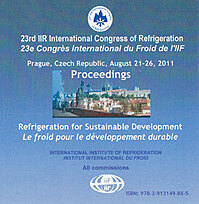
Document IIF
Caractérisation et comparaison de deux prototypes de refroidisseurs évaporatifs indirects.
Characterization and comparison of two prototypes of indirect evaporative coolers.
Numéro : pap. ID: 141
Auteurs : VELASCO GÓMEZ E., TEJERO GONZÁLEZ A., REY MARTÍNEZ F. J.
Résumé
Two polycarbonate heat exchangers have been experimentally characterized in two heat-recovery operation modes. The prototypes are designed with a total heat exchange area of 5.6 and 3 m2 respectively. The experimental setup constructed for the tests mainly consists of: an air handling unit to simulate the outdoor airstream conditions, a conditioned climate chamber, and a water circuit to provide the water supply required. In the first operation mode, exhaust air from the conditioned space goes through one side of the heat-exchanger, while outside air flows through the other, heat transfer being transferred through the polycarbonate walls from one stream to the other. To perform the evaporative cooling process, water is supplied to the exhaust airstream. Results are analysed considering how heat-exchange area, outside airstream volume flow rate and temperature, as well as mode of operation influence in the performance obtained. The parameters studied for the different conditions performed are: cooling capacity, thermal effectiveness and thermal conductance.
Documents disponibles
Format PDF
Pages : 8 p.
Disponible
Prix public
20 €
Prix membre*
Gratuit
* meilleur tarif applicable selon le type d'adhésion (voir le détail des avantages des adhésions individuelles et collectives)
Détails
- Titre original : Characterization and comparison of two prototypes of indirect evaporative coolers.
- Identifiant de la fiche : 30001550
- Langues : Anglais
- Source : Proceedings of the 23rd IIR International Congress of Refrigeration: Prague, Czech Republic, August 21-26, 2011. Overarching theme: Refrigeration for Sustainable Development.
- Date d'édition : 21/08/2011
Liens
Voir d'autres communications du même compte rendu (569)
Voir le compte rendu de la conférence
Indexation
-
Thèmes :
Equipements d'humidification/déshumidification;
Conditionnement d'air pour le confort;
Autres frigorigènes - Mots-clés : Air extrait; Comparaison; Conditionneur d'air; Récuperation de chaleur; Prototype; Performance; Système évaporatif; Experimentation; Conditionnement d'air; Échangeur de chaleur
-
Challenges of air conditioning decarbonization.
- Auteurs : PACAK A., CHOROWSKI M.
- Date : 21/08/2023
- Langues : Anglais
- Source : Proceedings of the 26th IIR International Congress of Refrigeration: Paris , France, August 21-25, 2023.
- Formats : PDF
Voir la fiche
-
Experimental investigation of hybrid air-condit...
- Auteurs : HIGASHI T., TOKUNAGA K., ZHANG L., SAIKAWA M., DANG C., HIHARA E.
- Date : 10/07/2022
- Langues : Anglais
- Source : 2022 Purdue Conferences. 19th International Refrigeration and Air-Conditioning Conference at Purdue.
- Formats : PDF
Voir la fiche
-
Case studies to evaluate the applicability of p...
- Auteurs : TEJERO GONZÁLEZ A., VINAS MALILLOS S., ESQUIVIAS FERNANDEZ P. M., VELASCO GÓMEZ E., REY MARTÍNEZ F. J.
- Date : 11/11/2020
- Langues : Anglais
- Source : X Congreso Ibérico y VIII Congreso Iberoamericano de Ciencias y Técnicas del Frío, CYTEF 2020.
- Formats : PDF
Voir la fiche
-
Performance improvisation of window air conditi...
- Auteurs : SAWANT A. P., AGRAWAL N., NANDA P.
- Date : 21/08/2011
- Langues : Anglais
- Source : Proceedings of the 23rd IIR International Congress of Refrigeration: Prague, Czech Republic, August 21-26, 2011. Overarching theme: Refrigeration for Sustainable Development.
- Formats : PDF
Voir la fiche
-
Comparative study of the performances of a buri...
- Auteurs : MIRIEL J., BYRNE P., SERRES L., et al.
- Date : 10/06/2007
- Langues : Anglais
- Source : Clima 2007. WellBeing Indoors. Proceedings of the 9th REHVA World Congress [CD-ROM + Abstract book].
Voir la fiche
